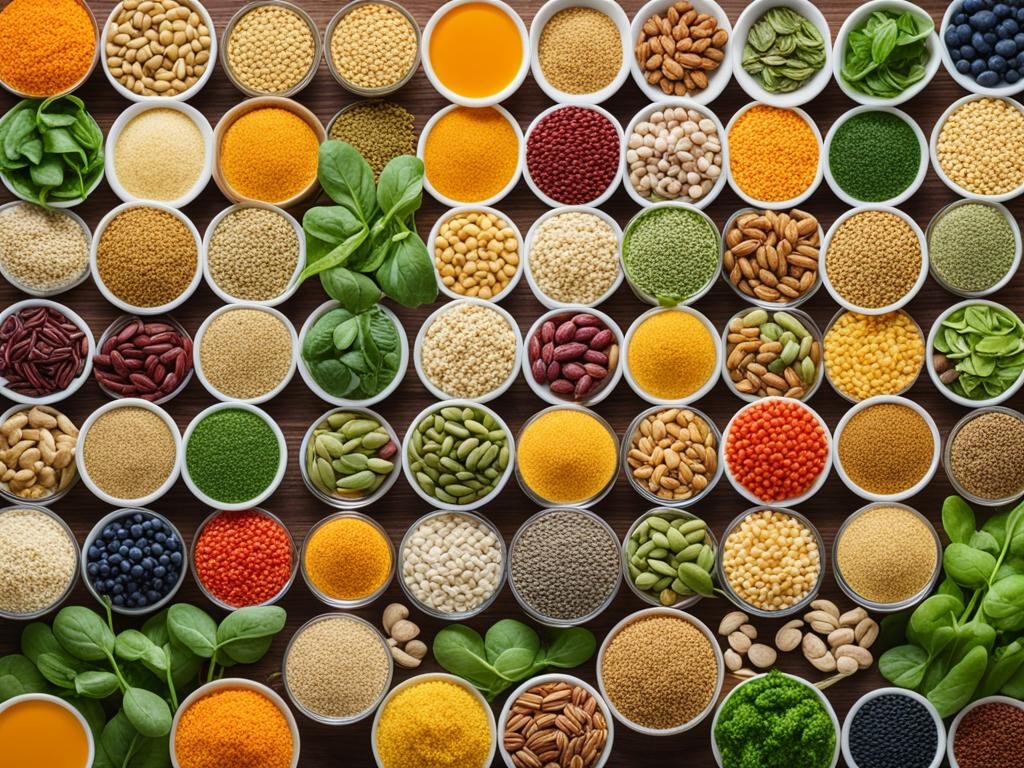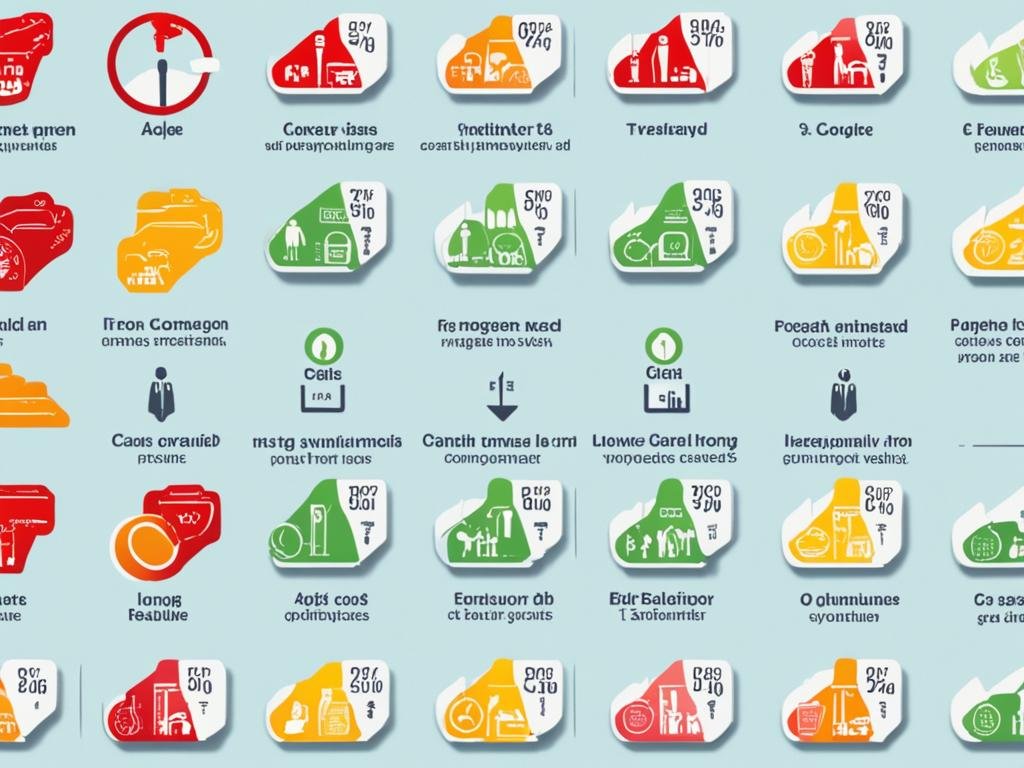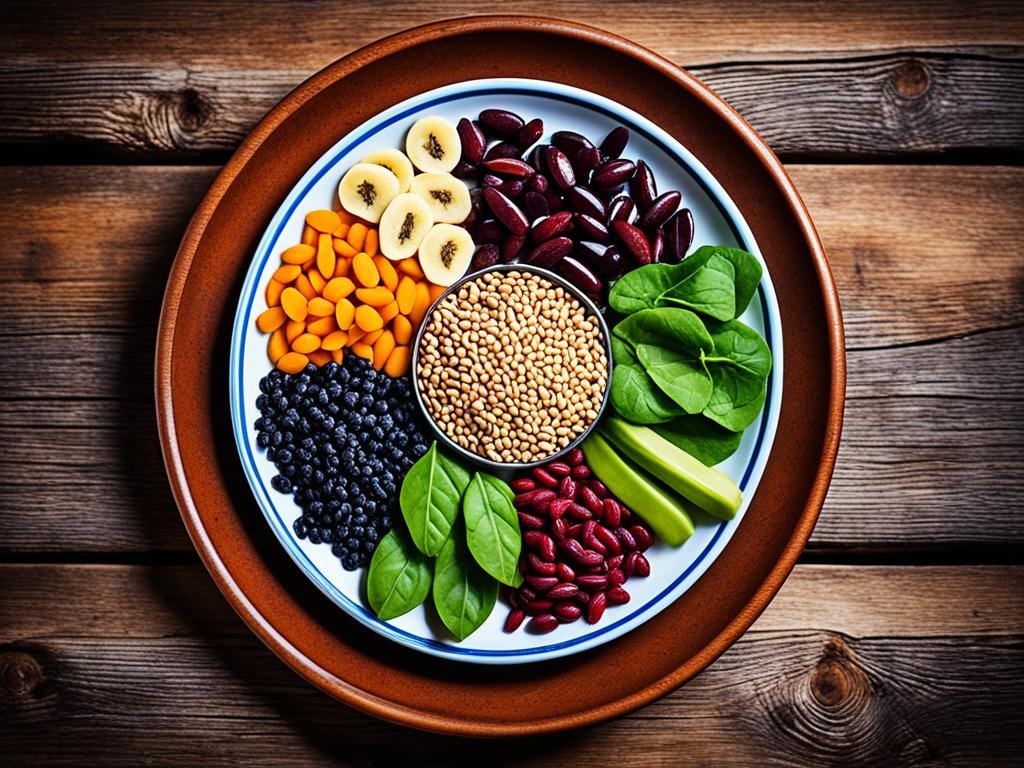Feeling tired constantly, having a hard time focusing, or finding it tough to breathe? You might not be getting enough iron. This mineral is key for moving oxygen around your body. Its role in keeping us healthy is huge. So, what foods are rich in iron? And how do you make sure you get enough to stay energetic and well? Let’s dive into these important questions.
Key Takeaways
- Iron is an essential mineral that carries oxygen throughout the body and supports energy production.
- Deficiency can lead to anemia, fatigue, and other health issues, especially for menstruating women.
- Heme iron from animal sources and non-heme iron from plant-based foods have different absorption rates.
- Pairing iron-rich foods with vitamin C can enhance absorption.
- Certain lifestyle factors, such as exercise and stress, can impact iron levels.
Importance of Iron in the Body
Iron is a crucial mineral for our health. It helps with many jobs inside us. Its main job is to transport oxygen throughout the body as part of hemoglobin in red blood cells.
Hemoglobin is a protein in red blood cells. It carries oxygen from the lungs to our tissues. This way, our bodies get the oxygen they need to work right.
Role in Oxygen Transportation
Iron and hemoglobin are essential. They make sure oxygen moves well in our bodies. If we lack iron, our oxygen distribution gets messed up. This can cause many health problems.
Proper oxygen transportation is key. It helps our organs and tissues work well. It keeps our energy and thinking sharp too.
Formation of Red Blood Cells
Iron is needed to make red blood cells. These cells carry oxygen and nutrients to our tissues. Hemoglobin, made with iron, is what makes red blood cells red. It helps them do their job of oxygen transport.
Essential for Energy Production
Iron is also big in making our energy. It’s part of certain enzymes that change food into energy. This process is called metabolism. Iron makes sure our bodies get the energy out of the food we eat.
Getting enough iron is a must for good health. It helps with many key functions. From oxygen moving to making energy, iron is crucial for our well-being.
Understanding Iron Deficiency
Not having enough iron in your body can cause iron deficiency. This is a significant problem with many symptoms. It affects your health and how you feel. It’s vital to know the signs, risks, and what happens if you don’t treat it to keep your iron levels up.
Symptoms of Iron Deficiency
Feeling tired, hard to focus, and out of breath are common signs. Iron helps blood carry oxygen. So, if you lack iron, your body might not get enough oxygen, making you feel tired and less sharp. Other signs include looking pale, having weak nails, and getting headaches.
Risk Factors for Iron Deficiency
Some people are more likely to have iron deficiency. For example, women who have periods lose iron every month, making them at risk. Also, pregnant women need more iron for the baby and to make extra blood. Plus, those on a plant-based diet should make sure to eat enough iron-rich foods or use vitamin C to help absorb iron.
Consequences of Untreated Iron Deficiency
If you don’t fix iron deficiency, it can get worse, leading to anemia. Anemia makes it hard for your body to carry oxygen, which affects many parts of your health. You might have trouble with thinking, your heart, and even get sick more often. Fixing iron levels early on is key for staying healthy.
Heme vs. Non-Heme Iron
When we talk about dietary iron, we mean two types: heme and non-heme. It’s important to know the difference between them. This knowledge helps ensure we get and absorb the iron our bodies need.
Heme Iron: Sources and Absorption
Heme iron is in animal foods like meat, poultry, and seafood. It’s easier for our bodies to absorb, about 15-35%. The chemical structure of heme iron lets our bodies use it readily.
Non-Heme Iron: Plant-Based Sources
Non-heme iron comes from plants, like veggies, grains, and legumes. It’s harder for our bodies to take in, only at 2-20%. Yet, adding vitamin C-rich foods to meals with non-heme iron boosts its absorption significantly.

Top Iron Rich Foods
If you’re looking to increase your iron intake, try adding shellfish, spinach, and organ meats to your diet. These foods are packed with iron. They are known as some of the high iron foods and best iron rich foods. By eating them, you can avoid iron deficiency and improve your overall health.
Shellfish
Shellfish like clams, oysters, and mussels are great sources of iron, particularly heme iron that’s easily absorbed. For instance, a 3.5-ounce serving of clams provides about 17% of your daily iron need. This makes them an excellent choice for boosting your iron levels.
Spinach
Spinach is a nutrient-rich leafy green packed with iron. 3.5 ounces of raw spinach has 2.7 mg of iron, which is 15% of your daily value. Plus, spinach is full of vitamin C. This vitamin helps your body absorb iron better.
Organ Meats
Beef liver is an excellent choice for increasing your iron intake. With about 36% of your daily iron need in each 3.5-ounce serving, it’s a great addition to your meals. Organ meats serve as a powerhouse of nutrients. They’re packed with protein, B vitamins, and important minerals besides iron.
Iron Rich Foods
Other iron-rich foods are legumes, red meat, and pumpkin seeds. They each help meet our body’s iron needs.
Legumes
Lentils, beans, and chickpeas provide plant-based sources of non-heme iron. Cooked lentils contain 37% of your daily iron needs in just one cup. They’re versatile and a great addition to meals.
Red Meat
Ground beef is rich in heme iron, offering 15% of daily iron needs in a 3.5-ounce serving. Our bodies absorb this type of iron more easily than non-heme iron from plants.
Pumpkin Seeds
In a 1-ounce serving, pumpkin seeds give us 14% of our iron needs for the day. They also pack magnesium and make an easy-to-take plant-based iron snack.

Enhancing Iron Absorption
To keep your iron levels healthy, it’s key to absorb it well. This helps prevent being iron-deficient. Eating vitamin C and steering clear of certain items really boosts how much iron the body takes in.
Role of Vitamin C
Foods high in vitamin C, like oranges, strawberries, and spinach, help a lot. They make it easier for the body to absorb iron from non-meats. This is a super important step since most of the iron in plants is non-heme. So, vitamin C turns this hard-to-absorb iron into an easy-to-take-in form.
Avoiding Iron Absorption Inhibitors
Some stuff can actually block your body from taking in iron if you have them with iron-rich foods. These no-goes are coffee, tea, and foods packed with calcium. These can stop your body from getting the full benefit of those beans, for example.
So, to really get the most out of the iron in your meals, skip the coffee with them. Instead, enjoy your caffeine or calcium treats at some other time.
Include lots of vitamin C in your meals and dodge these inhibitors. By doing this, you help your body grab and use iron from your food better.
Iron Needs by Age and Gender
The amount of iron we need changes with age and whether we’re male or female. Knowing how much iron to get is key to stay healthy and avoid not getting enough.
Recommended Dietary Allowance (RDA)
Kids and teens require more iron than grown-ups. A good example is that girls 14 to 18 years old need 15 mg daily. But, adult men only need 8 mg, and women need 18 mg to cover what they lose during their periods.
Special Considerations for Menstruating Women
Women who have their period lose a lot of iron and are at risk of being low. It’s important for them to eat foods high in iron. And if needed, they should talk to a doctor about iron pills.
Iron Requirements During Pregnancy
When a woman is pregnant, she needs even more iron, about 27 mg each day. This extra iron helps her make more blood and support the baby’s growth. Getting enough iron during pregnancy keeps both the mother and baby healthy.

| Age Group | Iron RDA (mg/day) |
|---|---|
| Children (1-13 years) | 7-11 mg |
| Teenage Girls (14-18 years) | 15 mg |
| Adult Men | 8 mg |
| Adult Women | 18 mg |
| Pregnant Women | 27 mg |
Combining Iron-Rich Foods
Eating foods high in iron with ones high in vitamin C is key. This kind of meal planning for iron makes sure your body uses non-heme iron better. Featuring a mix of iron-rich foods and vitamin C-rich companions in your meals boosts your iron intake. It’s good for your health all around.
Complementary Food Combinations
It’s smart to eat iron-rich foods with vitamin C-rich ones. For instance, pair spinach, lentils, or red meat with things like citrus fruits or bell peppers. This complementary food combination is a game-changer. It makes sure your body gets the most from the iron in your diet.
Meal Planning Strategies
For meal planning for iron, aim for a variety of iron-rich foods all day. Kick off with a spinach and tomato omelet. Then, for lunch, feast on a lentil and bell pepper salad. Cap your day with grilled salmon and roasted broccoli. Mixing iron sources with vitamin C-rich foods is the way to go. It boosts iron absorption and helps you hit your daily iron goals.

Iron Supplements: When to Consider
Adding plenty of iron-rich foods to your meals is the best way to ensure you get enough iron. But sometimes, you might need iron supplements. Always talk to a doctor before you start taking them.
Consult with a Healthcare Professional
First, a doctor or a dietitian should check what you really need. They will tell you how much iron supplement to take. They’ll also make sure you don’t take too much, adjusting the dose if necessary.
Potential Side Effects and Precautions
Iron pills help fix an iron shortage, but they can have side effects. Too much iron might make your stomach hurt or cause constipation, nausea, and vomiting. In serious cases, it could damage your organs. So, always follow your doctor’s advice on how much to take to prevent problems.
Lifestyle Factors Affecting Iron Levels
Working out often can boost your body’s need for iron. This happens because physical activity increases how many red blood cells you use. Mixing up your workout with different activities can keep your iron levels in check.
Chronic stress is bad for iron. It can mess with how your body uses and takes in iron, leading to a possible shortage. Doing activities like meditation or yoga can lower stress and help your body use iron better.
Exercise and Iron Absorption
Any physical activity can raise your iron needs. When you work out, your body uses more oxygen. To meet this demand, your red blood cells work harder, needing more iron to make new cells.
Stress and Iron Deficiency
Long-term stress can lower your iron levels. It affects how your body processes iron, making you more likely to have too little iron. The hormones from stress can mess with the way your body takes in and moves around iron.
Eating well and staying active is key to keeping your iron levels good. This can also help keep your whole body healthy.
Conclusion
Eating a mix of iron-rich foods is key for your health. Try adding shellfish, spinach, organ meats, and more to your meals. This will help you keep your iron levels up and stay healthy.
It’s important to know that there are different types of iron. Knowing how to boost iron absorption can make a big difference. By focusing on foods rich in iron and not skipping any meals, you can feel more alert, think better, and stay in good health.
Iron not only helps oxygen get around your body. It also helps your body make red blood cells and create energy. It’s key to eat a diet that’s balanced and full of iron. Sometimes, supplements may also be needed to make sure you’re getting enough.
Choosing the right foods can help a lot. Aim to eat various iron-rich foods regularly. This will support your health and the good things iron does for you. With a few smart food choices, you can keep your iron at healthy levels. This, in turn, will help you be a healthier, happier you.

